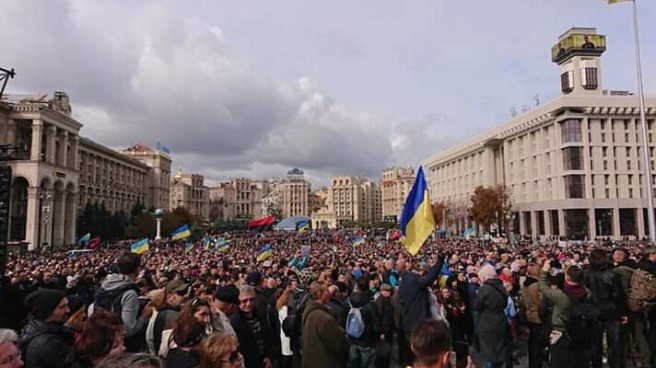Over the last few years, people have learned that politics and the business of running a country in Ukraine can be a little volatile. Two revolutions in the last 15 years and the war in the East were not a receipt for stability. Zelensky’s crushing victory in the Presidential election in April and in the parliamentary elections in July could have be a sign of more predictable times ahead. But those expecting boring politics in Ukraine may be in for another interesting disappointment.
The last few days have seen an increasing number of people gathering in Kiev and other Ukrainian towns to demonstrate against the so called “formula Steinmeier”, a peace plan for the Donbass war proposed by the then German Foreign Minister and supported by France and Germany. The plan envisages local elections under international monitoring in the territories not controlled by the Ukrainian government that today constitute the Donetsk and Luhansk People’s Republics. This is however perceived as a capitulation, a capitulation to Russia and Putin, by a large section of Ukraine’s most prominent political activists. And they blame for it the new President.

Arguably Zelensky’s most important campaign message before the last election was that he would stop the war in Donbass. This helped him secure his landslide victory over former President Poroshenko, who played the patriotic card of an endless confrontation with Russia, in a civilizational battle between “Europe” and the revanchist Russian “empire”. The promise of ending the war may have scored many points with the vast majority of the Ukrainian electorate, but it does not appear to be a priority for the most active members of Ukrainian emergent “civic society”, nor for the Ukrainian postrevolutionary intellectual elite, who in large numbers embraced Poroshenko’s civilization choice of unquestionable European and Transantlatic integration.
Not that the new Ukrainian President was going to change anything about Ukraine’s integration into the West, which inevitably meant would be moving away from the Russian economic and security space. The destiny of Ukraine has been sealed and no elections could ever possibly change that. Zelensky’s “betrayal” constitutes in having officially agreed to the “Steinmeier’s formula” last week. This could eventually lead to a federalization of Ukraine and a higher degree of autonomy for the Donbass region, and is a most unwelcome scenario for those who wish to see Ukraine as united and homogeneous, a Ukrainian-speaking bastion of “Europeanness” against the threat of Russianness. No compromise is viable on this and all compromise would be mean betrayal.
Could the demonstrations lead to Zelensky’s removal? It’s hard to say at the moment. On the Maidan square, the site of two epoch making revolutions for Ukraine over the last 15 years, some have already started to call for Zelensky’s dismissal and warned that this time [they] would not repeat the mistakes [they] did before, would not wait until there is blood on the streets to take action”.
“Mr President, you have time until the 14th of October. That day, if our conditions are not met, we will take to the streets in significantly higher numbers”, writes on its Facebook page the non-governmental organization “Defend Ukraine – Movement against Capitulation”. “If you try to implement some of the capitulation points through the Parliament or other governmental institutions – our protest will cease to be peaceful for good”.
According to the police in Kiev, some 10,000 people took part in the demonstrations on Sunday 6 October. According to the organizers, the protesters numbered 20,000. Former president Poroshenko joined the protesters as well. “The Steinmeier formula has been conceived by the Kremlin and protects Russia’s interests. Russia wants to make of the Donbass an analogue of Transdnistria”, Poroshenko wrote on his social media accounts.
The Maidan revolutions reinforced the romantic notion that the square represents the will of the nation against the forces of evil. Zelensky has proven reluctant to confront the issue, and although mass disorder on the streets would constitute a nuisance for the new government, the current numbers of demonstrators could hardly enact another “popular revolution”. Finally, Zelensky has not deviated from the strong pro-Western course of his predecessor, and the West is still behind him. Should this change, the threat of the square will be ever present.